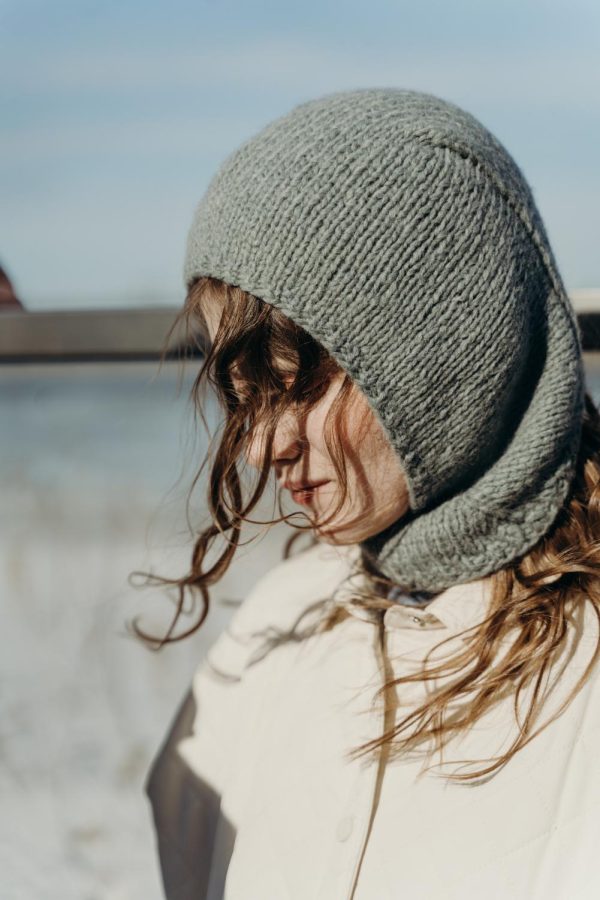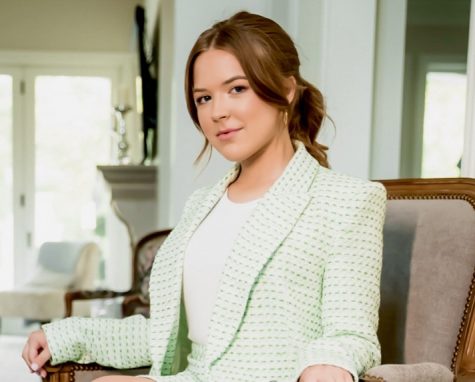Winter fashion is typically associated with pillowed silhouettes and thick layers as shape is compromised for warmth. The reemergence of the balaclava during the winter 2022 season brought a sleek contrasting look, but with it came the discussion of poignant double standards within the fashion industry.
During brutal Iowa winters, the balaclava may act as an ideal way to stay simultaneously warm and fashionable. Covering the whole head, this piece functions like a ski mask with various styles leaving holes for the entire face or just the eyes.
Early balaclavas were first used by English soldiers in the 1850s and have taken off in recent years in designs outside of practicality. Innovative designer Lirika Matoshi, most famous for her viral Strawberry Dress, embellishes her knit balaclavas with jewels and thick seams. Prada offers designs ready for the slopes with a chic aprés ski aesthetic.
The balaclava is not exclusive to luxury brands; the headwear has become so trendy that it has even found its way into mainstream chains like Target.
Modesty is rarely prioritized in modern Western fashion, so the popularization of this trend is something new and important for consumers – particularly women – who don unostentatious wardrobes. However, the full-coverage headwear has highlighted hypocrisy between fashion statements and religious garments with important subtext.
Throughout Paris Fashion Week in October 2021 and in runway shows as recent as Jan. 24, 2022, designers Kenzo, Wooyoungmi, Dsquared2 and more showcased a variety of balaclavic interpretations for their winter lines.
While this unique headwear is praised on the runway, France is a country where it is illegal for girls under 18 to wear headscarves or hijabs. Niqabs (full facial coverings) are illegal. French athletes may not wear hijabs in sports. Yet models donning the headwear and designers curating these looks are showered with praise. So where is the divide?
A New York Times article described, “The balaclava resembles a hijab, a religious head scarf worn by Muslim women. Head scarves are typically worn to maintain modesty or serve as religious symbols, but can hold different meanings depending on the wearer. Wearing a hijab is often a deeply personal experience.”
Freshman Samara Khan elaborated, “To me, wearing a headscarf and a hijab is a devotion and a form of worship to our God. It symbolizes modesty and respect for oneself in a way that we don’t want people to judge us solely off of our appearance. We want [society] to know who we are as people and not just what we look like [or choose to wear].”
While the United States Constitution protects the freedom of religion under the 1st Amendment, islamophobic legislation throughout the past two decades has still toiled to prevent the fundamental right to wear headscarves, hijabs, niqabs, burqas and other customary garments. For Muslims, choosing to wear any of these pieces is a liberating testament in faith.
Khan went on to describe various double standards she disagrees with within the fashion industry regarding race, body type, sex and other various stereotypes. She believes “[f]ashion shouldn’t only be for certain people.”
Khan continued, “A part of me really wants to enjoy the balaclava, but at the same time that double standard of being viewed as a terrorist if you’re wearing a headscarf as a Muslim woman but then being viewed as an iconic fashionable person when wearing a balaclava is offputting to me.” She concluded, “It’s modest until it’s made a trend. It’s cute and it’s trendy, but then a Muslim woman – or even someone who just looks Muslim – puts it on and it’s suddenly this act of terrorism and oppression. The hypocrisy kind of makes the whole trend ugly to me.”
On Jan. 28, Vogue France posted an image on Instagram of Julia Fox, a white American actress, wearing a kerchief around her head with the caption, “Yes to the headscarf!” Their complete lack of awareness for the climate surrounding hijabs in contemporary French culture was appalling, and again, a white woman was praised for something a hijabi Muslim would be ostracized for. After receiving heavy backlash across various social media platforms, Vogue changed the caption to a recap.
In the same post, Kanye West was featured wearing a full-coverage black mask reminiscent of the ones he and ex-wife Kim Kardashian wore at the 2021 MET Gala. Muslim author Hafsa Lodi writes for Independent, a popular English news source. She conveyed her thoughts, “Women who wish to wear niqabs in France face fines and citizenship education classes, yet Kanye is free to walk around on public streets and at prestigious fashion shows with his face fully covered.”
Vogue is an internationally respected publication, but uninformed, tone deaf comments and pictures like these perpetuate persecution to their audience of millions. If leading platforms are not held accountable to extinguish double standards, then they will just continue to spread.
PV art teacher Aimee Peters shared her insight on the motivation behind the trend. “I think it’s the intent of the people that are making it popular. If their intention is to make [headwear] not such a polarizing thing- if their intention is, ‘we’re going to make it high fashion so that other people who are wearing it for religious purposes are not being persecuted,’ then kudos to that. But if it’s being done more for appropriation, then that’s not okay. It’s a double standard. That’s wrong.”
Muslim women are consistently discriminated against for wearing headscarves – even though it is their choice to do so for their body and faith. Banning religious garments for national security yet praising physically-adjacent fashion trends demonstrates that the only “issue” with sacred headscarves is fractured prejudice toward the individuals who choose to wear them.
Various other religions and cultures also implement sacred clothing pieces into their lifestyles, and if brands continue to successfully sell secular pieces of similar design without criticism, then it can be inferred that oppression of cultural garments comes not from a disapproval of their look but from a purely islamophobic, anti-semetic, antirelgious or simply hateful place.
Toronto content creator and student Sagal Jama put it best in a New York Times interview. “You can take off a balaclava and abandon the trend, but race, religion and gender are things that somebody can’t just wake up and abandon.”









